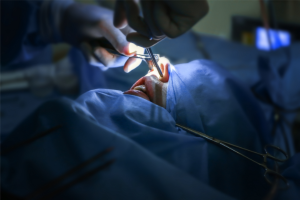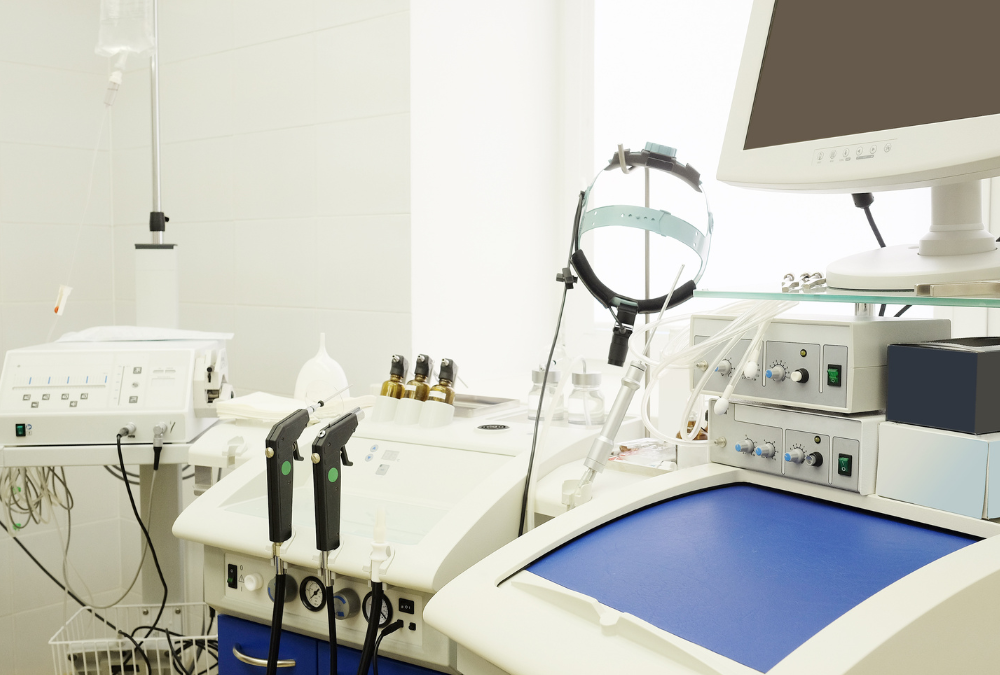This guide explores common procedures in Ear, Nose, and Throat (ENT) surgeries, emphasizing their role in addressing various hearing, breathing, and speech issues. It aims to provide a clear understanding of the intricate techniques employed by ENT specialists to restore health and function for patients. ENT surgery is an effective treatment option for many conditions, including chronic infections, structural abnormalities, and complex issues affecting sensory organs. Surgical interventions serve as a hopeful solution, providing targeted relief, improved functionality, and an enhanced quality of life.
Ear Surgeries
Ear surgeries harmonize life’s soundtrack, mending hearing impairments, restoring balance, and enhancing overall well-being.
Tympanoplasty
Tympanoplasty is a surgical procedure performed to repair a perforated eardrum or address other issues affecting the middle ear. Tympanoplasty aims to restore the integrity of the eardrum and improve hearing. During the procedure, a surgeon typically makes an incision in the ear canal, lifts the ear canal skin, and accesses the perforated eardrum. The surgeon then grafts tissue onto the hole, creating a seal to promote healing and prevent recurrent infections. This surgery is commonly effective in restoring hearing and preventing further complications associated with a perforated eardrum.
Stapedectomy
Stapedectomy is a surgical procedure specifically tailored for hearing restoration in otosclerosis cases. Otosclerosis is characterized by abnormal bone growth in the middle ear, which can lead to hearing loss. During this procedure, conducted under general anesthesia, the surgeon addresses the otosclerosis-induced hearing impairment by surgically replacing the stapes bone in the middle ear with a prosthetic device. The stapes bone plays a crucial role in transmitting sound vibrations, and when affected by otosclerosis, it can impede proper sound conduction. This type of surgical intervention significantly improves the patient’s hearing, effectively solving otosclerosis-related hearing loss.
Myringotomy with Tube Placement
Myringotomy is a medical procedure that involves making a small incision in the eardrum, known as the tympanic membrane. This procedure is commonly performed to address issues related to the middle ear, such as recurrent ear infections or excessive fluid that may affect hearing. The incision allows for the drainage of fluid or pus from the middle ear, reducing pressure and preventing further complications. Sometimes the insertion of a small tube into the incision is necessary to facilitate proper ventilation and drainage.
Nose Surgeries
Nose surgeries sculpt more than just appearances; they refine breathing, correct nasal issues, and boost confidence.
Septoplasty
Septoplasty is a surgical procedure that corrects the structure of the nasal septum (deviated or crooked septum), the thin wall of cartilage and bone that divides the nasal cavity into two nostrils. Septum defects can cause severe breathing difficulties, nasal congestion, and other upper respiratory-related issues. During the procedure, the surgeon adjusts or removes parts of the septum to create a more even and unobstructed nasal passage, thereby improving airflow and alleviating associated symptoms.
Rhinoplasty
Rhinoplasty
The surgeon typically makes incisions within the nostrils or, in some cases, on the external nose, allowing for careful manipulation of the nasal structure. Rhinoplasty requires a delicate balance between achieving the patient’s desired aesthetic goals and maintaining or improving nasal function, resulting in a harmonious and natural-looking outcome.
Sinus Surgery (Functional Endoscopic Sinus Surgery – FESS)
Functional Endoscopic Sinus Surgery (FESS) is a minimally invasive surgical procedure that addresses issues related to chronic sinusitis and nasal polyps. FESS involves utilizes an endoscope, a thin, flexible tube with a light and camera, to navigate and visualize the sinus passages. FESS aims to improve sinus drainage and ventilation by precisely removing nasal polyps and clearing obstructed or inflamed sinus tissue. The surgery provides relief from chronic sinusitis symptoms and enhances overall sinus function. FESS provides targeted intervention in problem areas to improve airflow and reduce the likelihood of recurrent sinus issues. FESS is an effective and widely used surgical solution for individuals experiencing chronic sinusitis and nasal polyps, offering long-term relief and improved quality of life.
Throat Surgeries
Throat surgeries soothe more than whispers; they alleviate swallowing troubles, silence persistent snoring, and bring relief to the vocal cords, orchestrating a melody of well-being.
Tonsillectomy
Tonsillectomy is a surgical procedure involving the removal of the tonsils, which are two small masses of tissue located at the back of the throat. This surgery is commonly performed to address recurrent or chronic infections of the tonsils, such as tonsillitis, and to alleviate breathing difficulties and sleep-related issues, including obstructive sleep apnea, associated with enlarged tonsils.
During the procedure, the surgeon typically uses a scalpel or another surgical instrument to excise the tonsils, and the surgery is often performed under general anesthesia. Tonsillectomy is a well-established and routine procedure, particularly in cases where conservative treatments like antibiotics have proven insufficient in managing chronic tonsil-related conditions.
Adenoidectomy
Adenoidectomy is a surgical procedure involving the removal of the adenoids, which are small masses of tissue located at the back of the nasal cavity near the throat. This procedure is commonly performed to address recurrent infections, chronic nasal congestion, and breathing difficulties associated with enlarged or inflamed adenoids. Adenoidectomy is often recommended when conservative treatments, such as antibiotics, fail to alleviate persistent symptoms.
The surgery is typically conducted under general anesthesia, and during the procedure, the surgeon removes the adenoid tissue using specialized instruments. Adenoidectomy is a routine and well-established surgical intervention, especially in cases where enlarged adenoids contribute to chronic respiratory and ear-related problems in children.
Laryngoscopy
Laryngoscopy is a diagnostic or surgical procedure that examines the larynx (voice box) using a specialized instrument called a laryngoscope. This slender, flexible, or rigid tube is equipped with a light and a camera, allowing healthcare professionals to visualize the structures within the larynx. Laryngoscopy serves various purposes, including evaluating vocal cord function, detecting abnormalities such as tumors or polyps, and diagnosing voice-related issues.
The procedure can be performed transnasally (through the nose) or transorally (through the mouth), and it is often employed in both outpatient and inpatient settings. Laryngoscopy is crucial for accurately diagnosing and managing conditions affecting the larynx, aiding in developing appropriate treatment plans for voice and swallowing disorders.
Head and Neck Surgeries
Head and neck surgeries navigate delicate landscapes, remedying tumors, improving aesthetics, and restoring functions.
Thyroidectomy
Thyroidectomy is a surgical procedure involving the partial or complete removal of the thyroid gland, which is situated in the neck and plays a key role in regulating metabolism. This procedure is typically recommended for individuals with various thyroid-related conditions, including thyroid cancer, hyperthyroidism, or the presence of large thyroid nodules causing compression or difficulty swallowing.
Surgeons can execute a total thyroidectomy, removing the entire gland, or a partial thyroidectomy, leaving a portion of the thyroid intact. Following the surgery, individuals may need lifelong thyroid hormone replacement therapy to maintain proper metabolic function. Thyroidectomy is a well-established procedure that aims to address thyroid disorders and, in cases of thyroid cancer, to prevent the spread of malignant cells.
Parotidectomy
Parotidectomy is a surgical procedure involving the removal of the parotid gland, one of the major salivary glands located on either side of the face, just in front of the ears. This procedure is typically conducted to treat conditions affecting the parotid gland, such as tumors, cysts, or chronic inflammation. Parotidectomy is performed under general anesthesia, and the surgeon carefully excises the affected gland while preserving nearby nerves responsible for facial movement and sensation.
The extent of the surgery depends on the nature and location of the condition, and it may involve either a partial or total removal of the parotid gland. Postoperatively, individuals may experience temporary or permanent changes in salivary flow, and meticulous surgical technique minimizes potential complications. Parotidectomy aims to address parotid gland disorders, alleviate symptoms, and, when necessary, prevent the spread of malignant tumors.
Neck Dissection
Neck dissection is a surgical procedure involving the removal of lymph nodes and other tissues from the neck. This procedure is commonly performed to treat or diagnose conditions related to the spread of cancer, particularly in the head and neck region. During neck dissection, a surgeon carefully removes lymph nodes that may contain cancerous cells, as well as surrounding tissues that could be affected. The dissection’s extent depends on the cancer’s location and stage.
Types of neck dissection include selective neck dissection, modified radical neck dissection, and radical neck dissection, each involving varying degrees of tissue removal. Neck dissection is often part of a comprehensive treatment plan for head and neck cancers, and it aims to control the spread of cancer, improve prognosis, and guide further therapeutic interventions like radiation or chemotherapy.
Pediatric ENT Surgeries
Pediatric ENT surgeries tenderly sculpt young destinies, addressing ear infections, airway issues, and congenital anomalies.
Cochlear Implant Surgery
Cochlear implant surgery restores hearing in individuals with severe to profound hearing loss. The surgery involves the insertion of a small electronic device, the cochlear implant, into the inner ear. A surgeon makes a small incision behind the ear, places the implant in the cochlea, and threads electrodes into the cochlear duct. This implant directly stimulates the auditory nerve, allowing individuals to perceive sound by bypassing damaged hair cells in the cochlea.
The external component captures and transmits sound to the internal implant, converting it into electrical signals for the auditory nerve. Cochlear implant surgery has proven to be a highly effective intervention, providing a significant improvement in the ability to perceive and understand sounds for individuals with severe hearing impairment.
Cleft Palate Repair
Cleft palate repair is a surgical procedure performed to correct a congenital condition where there is an opening or gap in the roof of the mouth, known as the palate. This gap, commonly referred to as a cleft palate, can extend from the front of the mouth (near the lips) to the back (toward the throat), affecting speech, feeding, and facial structure. The surgery is typically conducted during early childhood, often between 6 and 18 months of age.
During the procedure, the surgeon makes incisions on both sides of the cleft and repositions the tissues to close the gap. In some cases, additional procedures may be necessary as the child grows to address speech or facial development issues. Cleft palate repair aims to restore normal function and appearance, allowing for improved speech and proper feeding and supporting the child’s overall development.
Considerations for Surgical Consultation
The decision to embark on the path of ENT surgery is momentous, demanding a symphony of careful consideration. A thorough evaluation by an ENT specialist forms the overture, a detailed exploration of the patient’s medical history, symptoms, and diagnostic tests. The consultation becomes a discourse that delves into potential risks, benefits, and alternative treatment options.
Conclusion
Ear, Nose, and Throat (ENT) surgeries encompass diverse procedures. From rhinoplasty to Functional Endoscopic Sinus Surgery (FESS) and Stapedectomy, each surgery serves a unique purpose in restoring function, relieving symptoms, or enhancing aesthetics. The consultation process plays a pivotal role in this journey, allowing patients to understand each proposed surgery, discuss potential outcomes, and explore alternative options. As we recapitulate the common ENT surgeries, it becomes evident that a personalized and informed approach, guided by the expertise of ENT specialists, ensures the most effective and tailored solutions for patients, ultimately contributing to improved outcomes.

